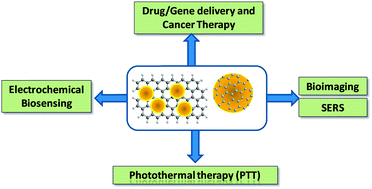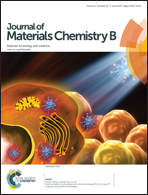Gold–graphene nanocomposites for sensing and biomedical applications
Abstract
Recent developments in materials science and nanotechnology have propelled the development of a plethora of materials with unique chemical and physical properties for biomedical applications. Graphitic nanomaterials such as carbon nanotubes, fullerenes and, more recently, graphene oxide (GO) and reduced graphene oxide (rGO) have received a great deal of interest in this domain. Besides the exceptional physico-chemical features of these materials, another advantage is that they can be easily produced in good quantities. Moreover, the presence of abundant functional groups on their surface and good biocompatibility make them highly suitable for biomedical applications. Many research groups have utilized GO and rGO nanocargos to effectively deliver insoluble drugs, nucleic acids and other molecules into cells for bioimaging and therapeutic purposes. Gold nanostructures (Au NSs), on the other hand, have also attracted great attention owing to their applications in biomedical fields, organic catalysis, etc. Loading of GO and rGO sheets with Au NSs generates a new class of functional materials with improved properties and thus provides new opportunities in the use of such hybrid materials for catalytic biosensing and biomedical applications. This review article is aimed at providing an insight into the important features of gold–graphene nanocomposites, the current research activities related to the different synthetic routes to produce these nanocomposites, and their potential applications in sensing and biomedical therapy, notably photothermal therapy (PTT).

- This article is part of the themed collection: JMC B Top Picks web collection: Seeing the unseen: Advances in bioimaging and biosensors

 Please wait while we load your content...
Please wait while we load your content...